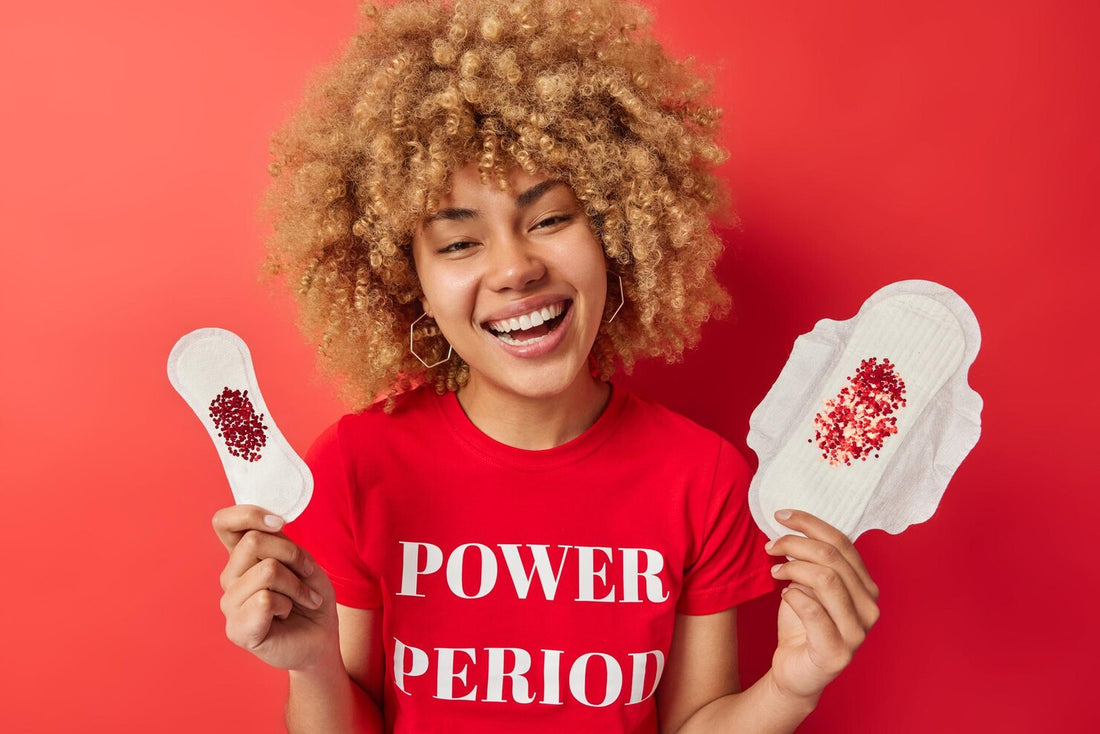As more and more consumers become aware of the ingredients in everyday products, The non toxic menstrual products has risen to the forefront. With concerns over toxins, allergens, and irritation, many are looking for chemical-free sanitary products, especially for menstruation. Are chemical-free pads the right choice for your health, comfort, and peace of mind? Let’s dive into why chemical-free period pads are gaining popularity and how they can benefit you.

Chemical-Free Period Pads: What You Need to Know
Chemical-free period pads are designed without any toxic or potentially harmful ingredients, such as titanium dioxide or irritating chemicals. Many traditional sanitary pads contain bleach, fragrances, and other chemicals that can irritate sensitive skin or disrupt the body’s natural balance. These concerns have led to a growing demand for organic and chemical-free alternatives.
At Happie Moon, we recognized the importance of offering a safe, chemical-free option for menstruators, particularly in the U.S. market. A few years ago, consumer demand for sanitary pads that don’t contain toxic substances prompted us to take immediate action. We worked diligently to ensure that all of our sanitary pads are free from titanium dioxide, chlorine bleach, and other harmful chemicals, ensuring a safer, more natural menstrual experience. Our products are certified, giving consumers confidence in their safety and effectiveness.
If you’re someone who values personal health and environmental responsibility, you’ll want to keep reading. There’s more to chemical-free pads than just the ingredients; they also offer benefits like reduced risk of irritation, a more comfortable fit, and the peace of mind that comes with using non-toxic menstrual products.

Questions People Ask About Chemical-Free Pads
Here’s a list of common questions about chemical-free pads and their benefits, with answers to help you make an informed decision:
1. What are chemical-free pads made of?
Chemical-free pads are often made from organic cotton, bamboo, or other natural, biodegradable materials. These materials are free from pesticides, bleach, and synthetic fragrances, which are commonly used in conventional pads. The outer layer is breathable, and the absorbent core is designed to lock moisture away without relying on harmful chemicals.
2. Are chemical-free pads safer for sensitive skin?
Yes, chemical-free pads are often gentler on sensitive skin. Traditional pads contain chemicals like chlorine and fragrances, which can cause irritation, rashes, and allergic reactions. Organic and chemical-free options, like those from Happie Moon, are less likely to cause discomfort and are a better choice for people with sensitive skin or those prone to irritation.
3. What’s wrong with regular pads?
Traditional sanitary pads often contain chemicals like titanium dioxide, chlorine bleach, and synthetic fragrances. These chemicals can not only irritate your skin but may also pose long-term health risks, including hormone disruption. Many of these products also take longer to decompose, adding to environmental concerns. The shift toward chemical-free, natural pads is seen as a healthier and more sustainable alternative.
4. Do chemical-free pads have the same absorbency as regular pads?
Yes, chemical-free pads can be just as absorbent as regular pads. At Happie Moon, we’ve worked hard to create a product that doesn’t compromise on performance. Our organic cotton pads are designed to offer maximum absorbency, keeping you dry and comfortable throughout the day. They are made to be breathable, ensuring that you don’t have to sacrifice comfort for safety.
5. Are chemical-free pads more expensive than regular pads?
Generally, chemical-free pads may be priced higher than regular pads, due to the cost of organic materials and the production process. However, the benefits—such as reduced chemical exposure, better skin health, and a more eco-friendly product—make them a valuable investment in your well-being.
6. Can chemical-free pads help with menstrual cramps or discomfort?
While chemical-free pads won’t directly reduce menstrual cramps, they can contribute to overall comfort. Without the irritation and discomfort caused by chemicals, you may experience less chafing, itching, or allergic reactions. This can lead to a more comfortable period experience overall.
7. Are there certifications to ensure chemical-free pads are safe?
Yes, many brands, including Happie Moon, offer certifications to back up their claims. These certifications guarantee that the pads are free from harmful chemicals like chlorine bleach and titanium dioxide. Always look for certifications from reputable organizations when shopping for organic or chemical-free period products to ensure they meet strict safety and quality standards.
8. How do chemical-free pads benefit the environment?
Chemical-free pads are not only healthier for your body but also better for the planet. Most conventional pads are made from synthetic materials and take hundreds of years to decompose. In contrast, organic cotton pads are biodegradable and decompose much faster, reducing their environmental footprint. By choosing chemical-free options, you’re making a positive impact on both your health and the planet.

Conclusion
Switching to chemical-free pads for your period is a smart choice for both your health and the environment. These products, like those offered by Happie Moon, provide a safer, more natural alternative to traditional pads filled with harsh chemicals. Whether you’re concerned about irritation, environmental impact, or just want to avoid unnecessary chemicals, chemical-free pads offer a reliable, comfortable solution.
By choosing products that prioritize safety and sustainability, you can ensure a more comfortable period experience and feel good about your choices. Make the change today and enjoy peace of mind knowing that you're using a product that is kind to both your body and the Earth.

